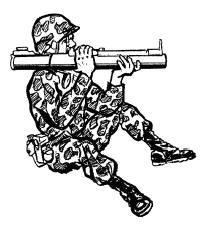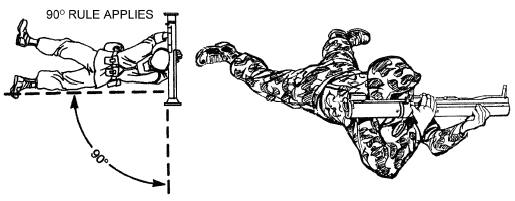Firing Positions for the M72 Series LAW
The M72-series LAW can be fired from either shoulder by simply reversing the
instructions. Though each weapon can be fired from all four of the basic firing
positions, individual physique determines exact body and hand positions. Firing
from a supported position naturally increases accuracy, which improves the odds
for a first-round hit or kill. Basic safety considerations are the same for all
light antiarmor weapons, but additional considerations for each firing position
are provided here.
STANDING POSITION
Two standing positions are used: a basic standing position and one modified
for the infantry fighting position.
Basic Standing Position
Raise the launcher slightly higher than shoulder level. Execute a left face,
rotate your shoulder under the launcher, and spread your feet a comfortable
distance apart. Move your left foot 15 to 24 inches forward, keeping your hips
level and your weight balanced on both feet. To obtain a firm, stable position,
tuck both elbows tightly into your body. To track a moving target, turn your
body at the waist―not with your legs. This enables you to track the target
smoothly. Unless you are behind a protective barrier, such as a wall, the
standing position exposes you more than any other position to enemy observation
and possible suppression. Place your nonfiring hand about 4 inches from the
front of the muzzle, with your firing hand on the rear cover. After placing the
weapon on your shoulder, release the rear cover and place your firing hand on
the trigger. Cup the launcher in the palm of your nonfiring hand. Position your
firing eye as close to the rear sight as is comfortable.
WARNING: Always keep the launcher pointed in the direction of fire.

Basic Standing Position
Modified Standing Position
Use this position when you occupy an infantry fighting position. Assume the
basic standing position, but instead of stepping forward, lean against the back
wall of the fighting position. Ensure that the venturi or rear of the weapon
extends beyond the rear of the fighting position. The figure below shows the
modified standing position for the M72-series LAW. Ensure that NONE of the
following are in your backblast area:
- Other Soldiers.
- Other fighting positions.
- Equipment.
- Any part of your own fighting position.
- Obstructions within 5 meters.
NOTE: Leaders must ensure that light antiarmor weapons are positioned so
that the backblast misses other fighting positions.
DANGER: NEVER FIRE FROM WITHIN A COMPLETELY ENCLOSED, UNVENTILATED
BUNKER OR FIGHTING POSITION.

Modified Standing Position
KNEELING POSITION
The basic kneeling position is the best position for tracking moving targets.
The modified kneeling position is best for engaging stationary targets, since it
is a supported position. However, either can be used for stationary or moving
targets.
Basic Kneeling Position
Kneel from the basic standing position onto your right knee, keeping your
left thigh parallel to the ground. Rotate your lower right leg 90degrees to the
left. (This removes your right foot from exposure to the backblast.) Keep your
right thigh and back straight and perpendicular to the ground. Point your left
foot in the direction of fire and tuck your elbows in to your sides. Though this
is not a supported position, it should be a firm, stable one. (The figure belows
shows the basic kneeling position.)

Basic Kneeling Position
Modified Kneeling Position
From the basic kneeling position, sit back on your right heel. Place the back
of your upper left arm on your left knee, making sure you do not have
bone-to-bone contact between your left elbow and left knee. Keep your right
elbow tucked in close to your right side. Use any protective barriers available.
(The figure below shows the modified kneeling position.)

Modified Kneeling Position
SITTING POSITION
The sitting position is the most stable firing position. In this position,
the arms are placed on the legs for support. Depending on his physique, the
firer can use either of two versions of the sitting position, which are both
suitable for engaging stationary targets.
Basic Sitting Position
Sit on your buttocks while facing the target, and spread your feet a
comfortable distance apart. Lean forward and place the backs of your upper arms
on your knees, avoiding bone-to-bone contact. (The figure below shows the basic
sitting position.)

Basic Sitting Position
Modified Sitting Position
From the basic sitting position, cross your ankles for added support. Raise
or lower your knees to adjust for elevation on the target. (The figure below
shows the modified sitting position.)

Modified Sitting Position
PRONE POSITION
The prone position is the most dangerous position due to its proximity to the
ground. Ideally, the ground should slope downward from the rear of the launcher,
which reduces the effects of the backblast.
- Lie on your stomach with your body at a 90-degree angle to the direction
of fire, and with your body and legs to the left of the direction of fire, for
the improved launcher lie with your body at a 45-degree angle. - Ensure that neither the body nor the legs are in the backblast area.
- Unlike other firing positions, the prone position prevents you from
placing the launcher on your right shoulder. Instead, you must hold the
launcher in place against your upper right arm. For stability, apply extra
pressure on the firing mechanism with your right hand. The prone position is
the least stable of all firing positions. You must practice it often to become
confident using it. (The figures below show the prone position for M72A2/A3
and the prone position for the M72A4/5/6/7 due to the improvements of the
rockets.)
DANGER: FAILURE TO MAINTAIN A 90-DEGREE OR A 45-DEGREE ANGLE FROM
THE DIRECTION OF FIRE COULD CAUSE INJURY OR DEATH TO THE FIRER.

Prone position for M72A2/A3

Prone position for the M72A4/5/6/7